Orthogonal Printed Microstrip Antenna Arrays for 5G Millimeter-Wave Applications
Abstract
:1. Introduction
2. Antenna Geometry
3. Development of the Array Antenna
4. Results
4.1. S-Parameter Analysis
4.2. Gain Analysis
4.3. Radiation Pattern
5. Validation
6. Conclusions
Author Contributions
Funding
Acknowledgments
Conflicts of Interest
References
- Tariq, S.; Naqvi, S.I.; Hussain, N.; Amin, Y. A Metasurface-Based MIMO Antenna for 5G Millimeter-Wave Applications. IEEE Access 2021, 9, 51805–51817. [Google Scholar] [CrossRef]
- Hastürkoğlu, S.; Lindenmeier, S. An automotive antenna set at 26.5 GHz for 5G-mobile communication. In Proceedings of the 2018 IEEE MTT-S International Conference on Microwaves for Intelligent Mobility (ICMIM), Munich, Germany, 15–17 April 2018; pp. 1–4. [Google Scholar]
- Neophytou, K.; Steeg, M.; Stöhr, A.; Antoniades, M.A. Compact fixed-beam leaky-wave antenna for 5G millimeter-wave applications. In Proceedings of the 2019 13th European Conference on Antennas and Propagation (EuCAP), Krakow, Poland, 31 March–5 April 2019; pp. 1–4. [Google Scholar]
- Liu, K.; Yang, S.; Qu, S.W.; Chen, Y.; Huang, M.; Hu, J. A low-profile wide-scanning fully metallic lens antenna for 5G communication. Int. J. RF Microw. Comput.-Aided Eng. 2021, 31, e22584. [Google Scholar] [CrossRef]
- 5G Technology World. Available online: https://www.5gtechnologyworld.com/record-and-analyze-signals-to-26-5-ghz/ (accessed on 17 July 2021).
- Cable Free. Available online: https://www.cablefree.net/wirelesstechnology/4glte/5g-frequency-bands-lte/ (accessed on 17 July 2021).
- Rappaport, T.S.; Sun, S.; Mayzus, R.; Zhao, H.; Azar, Y.; Wang, K.; Wong, G.N.; Schulz, J.K.; Samimi, M.; Gutierrez, F. Millimeter wave mobile communications for 5G cellular: It will work! IEEE Access 2013, 10, 335–349. [Google Scholar] [CrossRef]
- Sulyman, A.I.; Nassar, A.T.; Samimi, M.K.; MacCartney, G.R.; Rappaport, T.S.; Alsanie, A. Radio propagation path loss models for 5G cellular networks in the 28 GHz and 38 GHz millimeter-wave bands. IEEE Commun. Mag. 2014, 52, 78–86. [Google Scholar] [CrossRef]
- Bang, J.; Choi, J. A compact hemispherical beam-coverage phased array antenna unit for 5G mm-wave applications. IEEE Access 2020, 30, 139715–139726. [Google Scholar] [CrossRef]
- Kim, W.; Bang, J.; Choi, J. A Cost-Effective Antenna-in-Package Design With a 4 × 4 Dual-Polarized High Isolation Patch Array for 5G mmWave Applications. IEEE Access 2021, 9, 163882–163892. [Google Scholar] [CrossRef]
- Hong, W.; Baek, K.H.; Ko, S. Millimeter-wave 5G antennas for smartphones: Overview and experimental demonstration. IEEE Trans. Antennas Propag. 2017, 65, 6250–6261. [Google Scholar] [CrossRef]
- Gu, X.; Liu, D.; Baks, C.; Tageman, O.; Sadhu, B.; Hallin, J.; Rexberg, L.; Parida, P.; Kwark, Y.; Valdes-Garcia, A. Development, implementation, and characterization of a 64-element dual-polarized phased-array antenna module for 28-GHz high-speed data communications. IEEE Trans. Microw. Theory Tech. 2019, 67, 2975–2984. [Google Scholar] [CrossRef]
- Saad, A.A.; Mohamed, H.A. Printed millimeter-wave MIMO-based slot antenna arrays for 5G networks. AEU-Int. J. Electron. Commun. 2019, 99, 59–69. [Google Scholar] [CrossRef]
- Jiang, H.; Si, L.M.; Hu, W.; Lv, X. A symmetrical dual-beam bowtie antenna with gain enhancement using metamaterial for 5G MIMO applications. IEEE Photonics J. 2019, 11, 1–9. [Google Scholar] [CrossRef]
- Iqbal, A.; Basir, A.; Smida, A.; Mallat, N.K.; Elfergani, I.; Rodriguez, J.; Kim, S. Electromagnetic bandgap backed millimeter-wave MIMO antenna for wearable applications. IEEE Access 2019, 7, 111135–111144. [Google Scholar] [CrossRef]
- Murthy, N. Improved isolation metamaterial inspired mm-Wave MIMO dielectric resonator antenna for 5G application. Prog. Electromagn. Res. C 2020, 100, 247–261. [Google Scholar] [CrossRef] [Green Version]
- Zhang, Y.P.; Liu, D. Antenna-on-chip and antenna-in-package solutions to highly integrated millimeter-wave devices for wireless communications. IEEE Trans. Antennas Propag. 2009, 57, 2830–2841. [Google Scholar] [CrossRef]
- Zhang, Y.P.; Sun, M.; Chua, K.M.; Wai, L.L.; Liu, D. Antenna-in-package design for wire bond interconnection to highly integrated 60-GHz radios. IEEE Trans. Antennas Propag. 2009, 57, 2842–2852. [Google Scholar] [CrossRef]
- Karim, R.; Iftikhar, A.; Ramzan, R. Performance-Issues-Mitigation-Techniques for On-Chip-Antennas–Recent Developments in RF, MM-Wave, and THz Bands with Future Directions. IEEE Access 2020, 8, 219577–219610. [Google Scholar] [CrossRef]
- Karim, R.; Iftikhar, A.; Ijaz, B.; Mabrouk, I.B. The potentials, challenges, and future directions of on-chip-antennas for emerging wireless applications—A comprehensive survey. IEEE Access 2019, 7, 173897–173934. [Google Scholar] [CrossRef]
- Baki, A.K.M. Beamwidth reduction of binomial array for 5G communications. In Proceedings of the 2017 IEEE Region 10 Humanitarian Technology Conference (R10-HTC), Dhaka, Bangladesh, 21–23 December 2017; pp. 55–58. [Google Scholar]
- Maccartney, G.R.; Rappaport, T.S.; Sun, S.; Deng, S. Indoor office wideband millimeter-wave propagation measurements and channel models at 28 and 73 GHz for ultra-dense 5G wireless networks. IEEE Access 2015, 3, 2388–2424. [Google Scholar] [CrossRef]
- Valenzuela-Valdes, J.F.; Garcia-Fernandez, M.A.; MArtinez-Gonzalez, A.M.; Sanchez-Hernandez, D. Doubling MIMO capacity for handset MIMO using true polarization diversity. In Proceedings of the 2009 3rd European Conference on Antennas and Propagation, Berlin, Germany, 23–27 March 2009; pp. 1090–1092. [Google Scholar]
- Björnson, E.; Hoydis, J.; Sanguinetti, L. Massive MIMO networks: Spectral, energy, and hardware efficiency. Found. Trends Signal Processing 2017, 11, 154–655. [Google Scholar] [CrossRef]
- Kim, M.D.; Liang, J.; Lee, J.; Park, J.; Park, B.; Chung, H.K. Investigating the effect of antenna beamwidth on millimeter-wave channel charaterization. In Proceedings of the 2016 URSI Asia-Pacific Radio Science Conference (URSI AP-RASC), Seoul, Korea, 21–25 August 2016; pp. 1–4. [Google Scholar]
- Xue, Q.; Li, B.; Zuo, X.; Yan, Z.; Yang, M. Cell capacity for 5G cellular network with inter-beam interference. In Proceedings of the 2016 IEEE International Conference on Signal Processing, Communications and Computing (ICSPCC), Hong Kong, China, 5–8 August 2016; pp. 1–5. [Google Scholar]
- Watanabe, A.O.; Ali, M.; Tehrani, B.; Hester, J.; Matsuura, H.; Ogawa, T.; Raj, P.M.; Sundaram, V.; Tentzeris, M.M.; Tummala, R.R. First Demonstration of 28 GHz and 39 GHz Transmission Lines and Antennas on Glass Substrates for 5G Modules. In Proceedings of the 2017 IEEE 67th Electronic Components and Technology Conference (ECTC), Orlando, FL, USA, 30 May–2 June 2017; pp. 236–241. [Google Scholar] [CrossRef]
- Zhang, S.; Chen, X.; Syrytsin, I.; Pedersen, G.F. A planar switchable 3-D-coverage phased array antenna and its user effects for 28-GHz mobile terminal applications. IEEE Trans. Antennas Propag. 2017, 65, 6413–6421. [Google Scholar] [CrossRef] [Green Version]
- Balanis, C.A. Antenna Theory: Analysis and Design; John Wiley & Sons: Hoboken, NJ, USA, 2016. [Google Scholar]
- Li, Y.; Shen, H.; Zou, H.; Wang, H.; Yang, G. A compact UWB MIMO antenna for 4.5 G/5G wearable device applications. In Proceedings of the 2017 Sixth Asia-Pacific Conference on Antennas and Propagation (APCAP), Xi’an, China, 16–19 October 2017; pp. 1–3. [Google Scholar]
- Khan, A.; Geng, S.; Zhao, X.; Shah, Z.; Jan, M.U.; Abdelbaky, M.A. Design of MIMO antenna with an enhanced isolation technique. Electronics 2020, 9, 1217. [Google Scholar] [CrossRef]
- Yang, Z.; Xiao, J.; Ye, Q. Enhancing MIMO antenna isolation characteristic by manipulating the propagation of surface wave. IEEE Access 2020, 8, 115572–115581. [Google Scholar] [CrossRef]
- Alnaiemy, Y.; Elwi, T.A.; Nagy, L. Mutual coupling reduction in patch antenna array based on EBG structure for MIMO applications. Period. Polytech. Electr. Eng. Comput. Sci. 2019, 63, 332–342. [Google Scholar] [CrossRef]
- Watanabe, A.O.; Lin, T.-H.; Okamoto, D.; Pulugurtha, M.R.; Tentzeris, M.M.; Tummala, R.R. Package-Integrated, Wideband Power Dividing Networks and Antenna Arrays for 28-GHz 5G New Radio Bands. IEEE Trans. Compon. Packag. Manuf. Technol. 2020, 10, 1515–1523. [Google Scholar] [CrossRef]
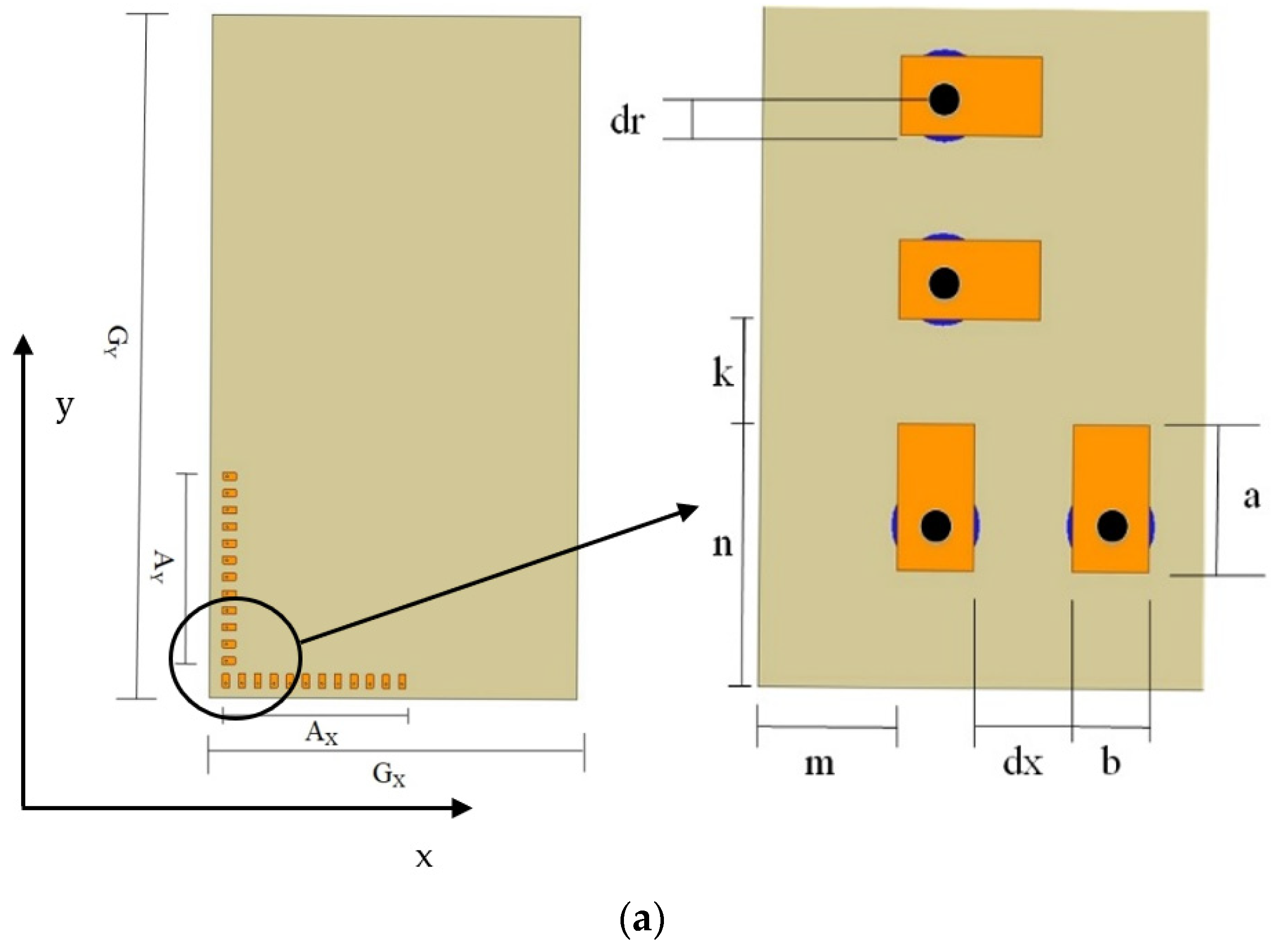

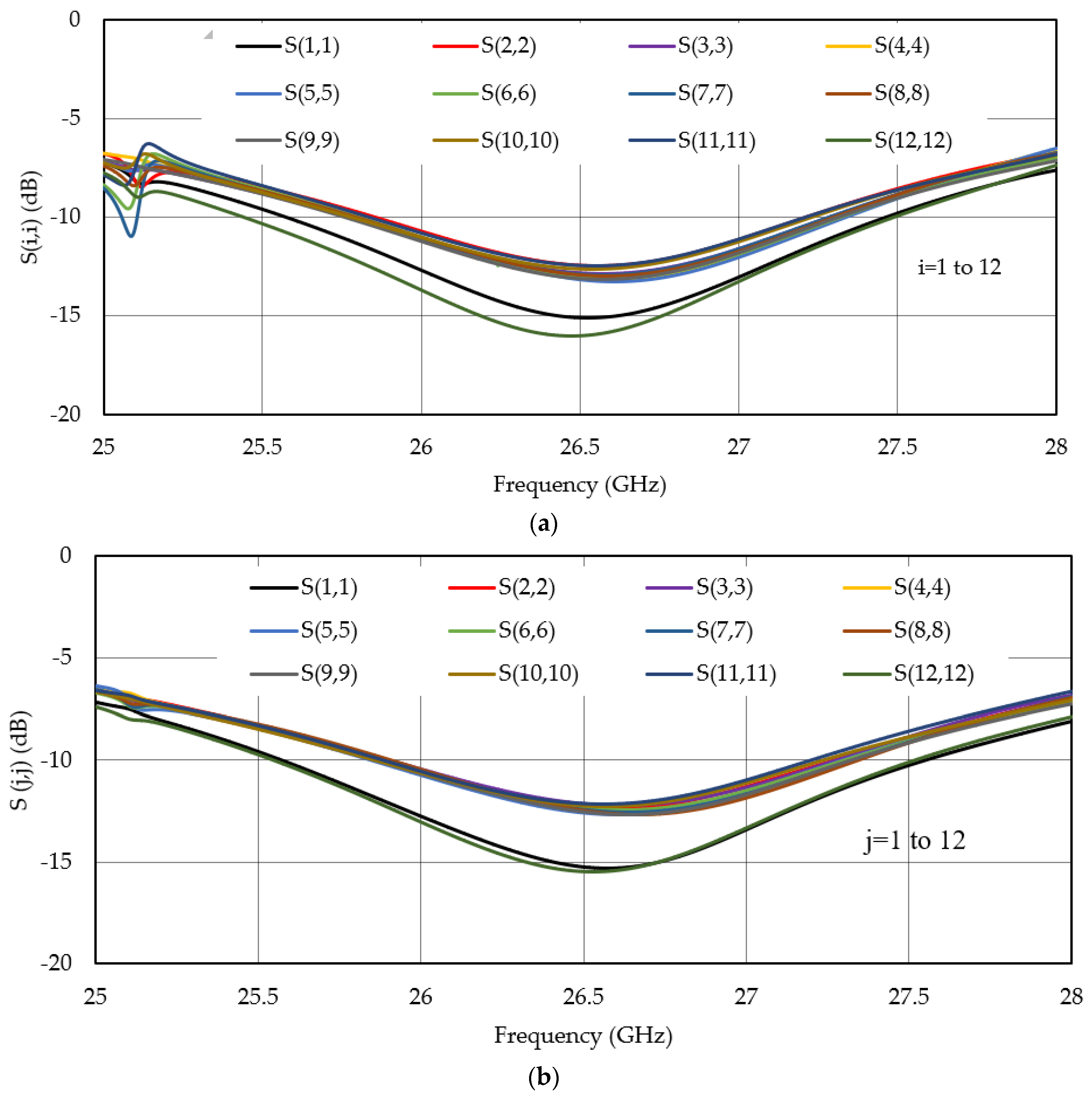
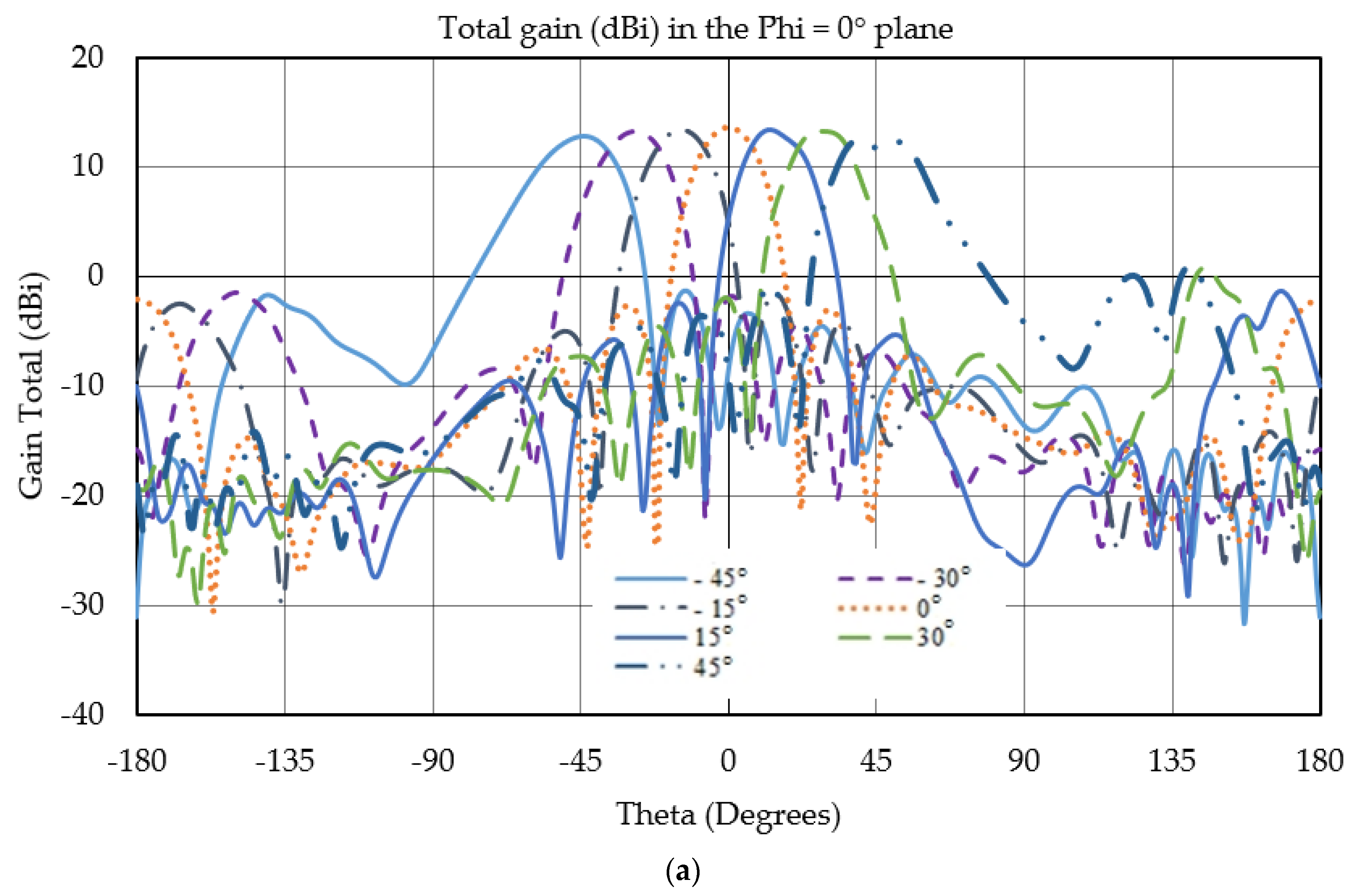


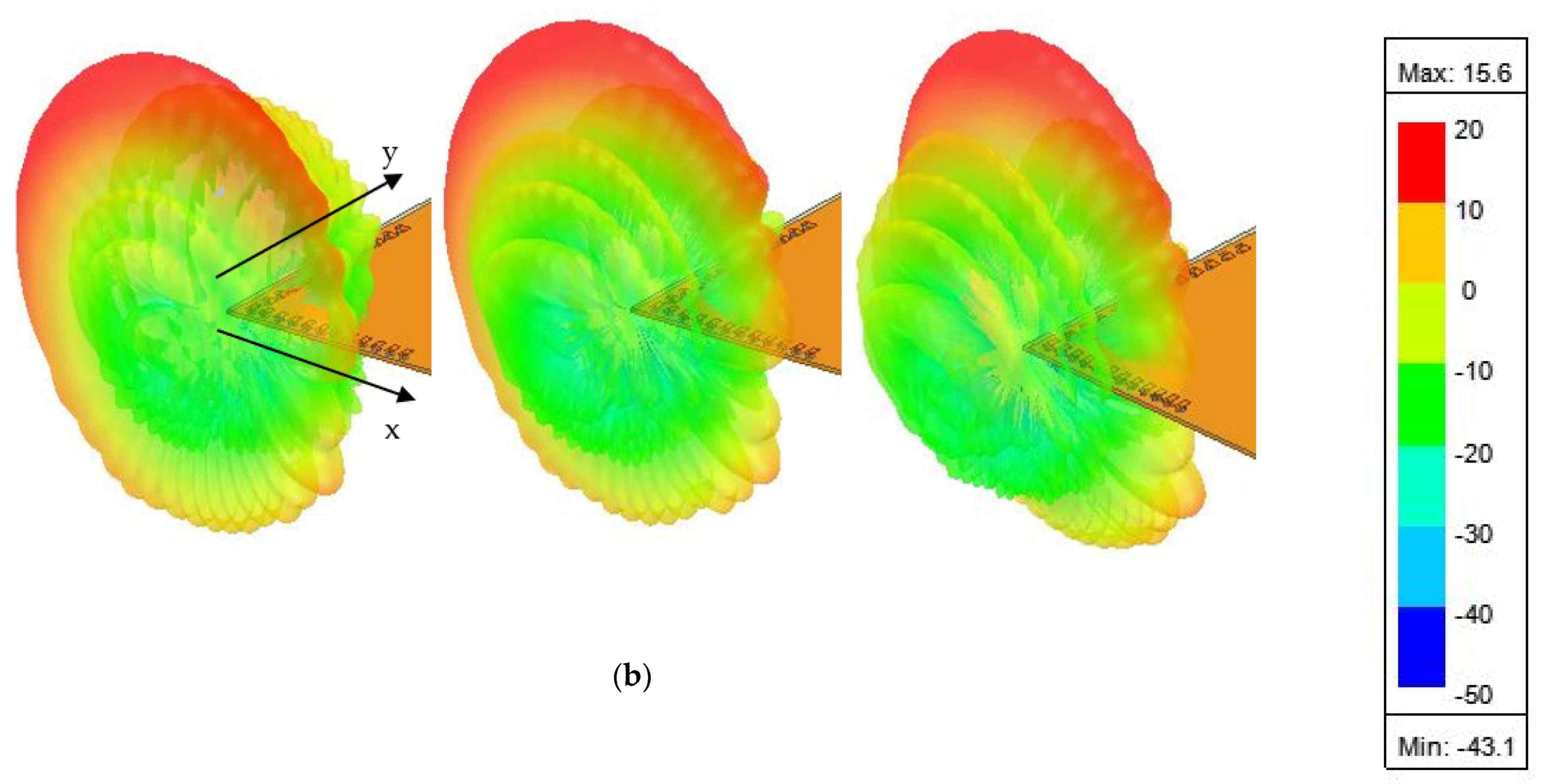
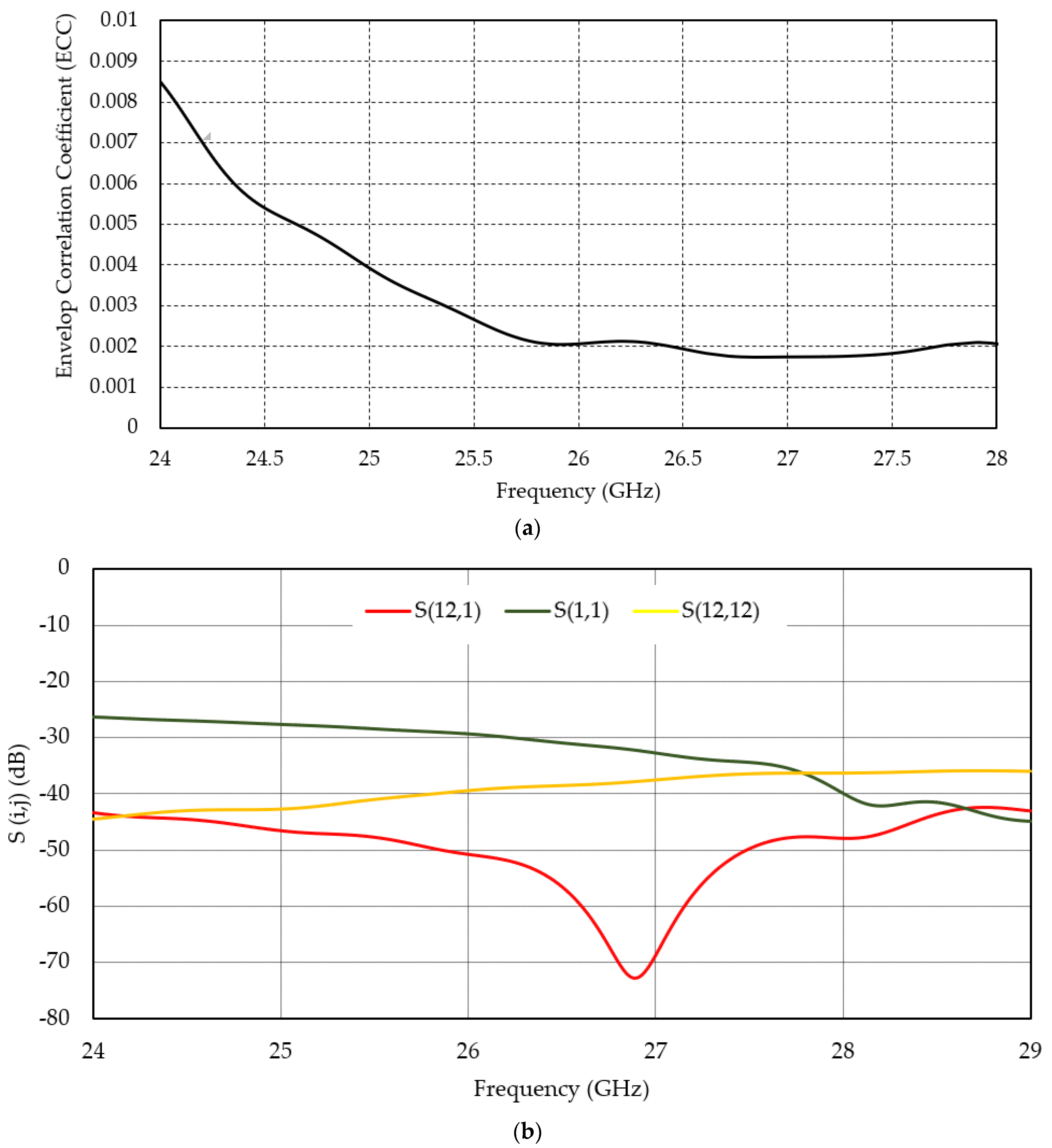
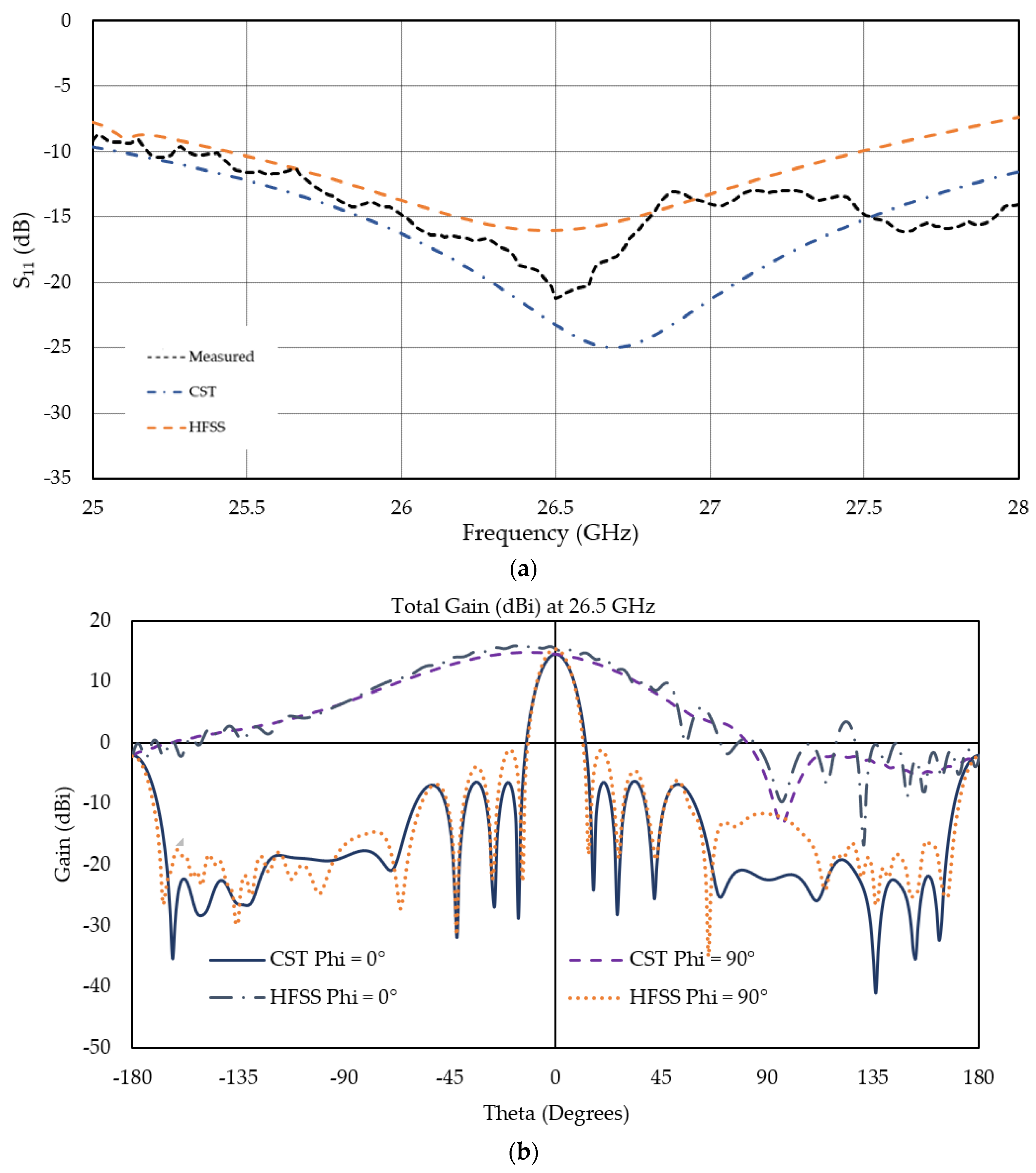
| GX | GY | AX | AY | k | m | n | a | b | dx | dr |
|---|---|---|---|---|---|---|---|---|---|---|
| 90 | 160 | 53.7 | 53.7 | 2.4 | 2.5 | 5.9 | 3.1 | 2 | 2.4 | 1 |
| Array Size | Broadside | 45° Scan | ||||
|---|---|---|---|---|---|---|
| X × Y | Gain (dB) | HPBW (°) | SLL (dB) | Gain (dB) | HPBW (°) | SLL (dB) |
| 1 × 4 | 9.93 | 34.76 | −15.33 | NC | NC | NC |
| 1 × 6 | 11.02 | 22.19 | −13.48 | 9.85 | 30.84 | −7.07 |
| 1 × 8 | 12.06 | 17.35 | −13.66 | 11.28 | 26.59 | −11.37 |
| 1 × 10 | 13.1 | 13.29 | −13.86 | 12.26 | 22.15 | −11.8 |
| 1 × 12 | 14.1 | 12.25 | −16.16 | 12.9 | 21.43 | −16.1 |
| 1 × 14 | 14.3 | 9.79 | −15.33 | 13.45 | 18.04 | −13.73 |
| Ref. | Substrate Material | Area (mm2) | Optimization Techniques | Operating Freq. (GHz) | Gain (dBi) | Isolation (dB) | ECC |
|---|---|---|---|---|---|---|---|
| [13] | Rogers RO4003 | 20 × 53 | MIMO | 28, 38 | 11.5, 10.9 | 20 | <0.12 |
| [14] | Rogers RT/duroid 5880 | 30 × 30.5 | MIMO + EBG | 26 | 7.4 | N/A | N/A |
| [15] | Rogers RT/duroid 6002 | 20 × 60 | DRA-based MIMO | 24 | 6 | 37 | 0.24 |
| [16] | Rogers RT/duroid 5880 | 20 × 40 | MIMO | 28 | 7 | 29.34 | 0.02 |
| [1] | Rogers RT/duroid 5880 | 21 × 85 | MIMO | 26 | 10.27 | 45 | 0.004 |
| [34] | 100 μm glass | 28.9 × 16.7 | Minimal matching | 27 | 9.51 | N/A | N/A |
| Proposed work | Rogers RT/duroid 5880 | X-Y arrays 53.5 × 3.1 3.1 × 53.5 | MIMO | 26.5 | 14 | 45 | <0.002 |
Publisher’s Note: MDPI stays neutral with regard to jurisdictional claims in published maps and institutional affiliations. |
© 2021 by the authors. Licensee MDPI, Basel, Switzerland. This article is an open access article distributed under the terms and conditions of the Creative Commons Attribution (CC BY) license (https://creativecommons.org/licenses/by/4.0/).
Share and Cite
Hossain, M.M.; Alam, M.J.; Latif, S.I. Orthogonal Printed Microstrip Antenna Arrays for 5G Millimeter-Wave Applications. Micromachines 2022, 13, 53. https://doi.org/10.3390/mi13010053
Hossain MM, Alam MJ, Latif SI. Orthogonal Printed Microstrip Antenna Arrays for 5G Millimeter-Wave Applications. Micromachines. 2022; 13(1):53. https://doi.org/10.3390/mi13010053
Chicago/Turabian StyleHossain, Muhammad M., Md Jubaer Alam, and Saeed I. Latif. 2022. "Orthogonal Printed Microstrip Antenna Arrays for 5G Millimeter-Wave Applications" Micromachines 13, no. 1: 53. https://doi.org/10.3390/mi13010053
APA StyleHossain, M. M., Alam, M. J., & Latif, S. I. (2022). Orthogonal Printed Microstrip Antenna Arrays for 5G Millimeter-Wave Applications. Micromachines, 13(1), 53. https://doi.org/10.3390/mi13010053






